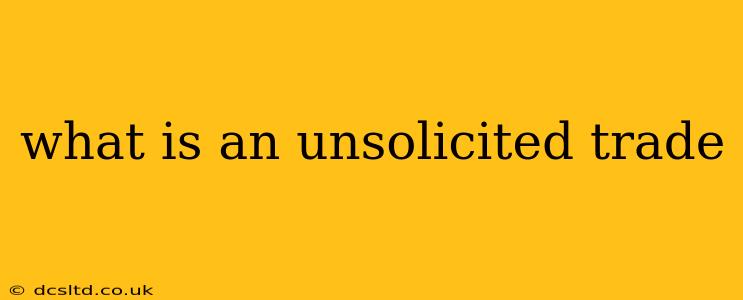What is an Unsolicited Trade?
An unsolicited trade, in the context of brokerage accounts and online trading platforms, refers to a trade executed in your account without your explicit authorization or prior consent. This is a serious issue that can result in significant financial losses and legal ramifications. It's crucial to understand what constitutes an unsolicited trade and how to protect yourself against them.
Unsolicited trades aren't simply trades you disagree with; they're trades made without your knowledge or approval. They represent a breach of trust and potentially a violation of securities regulations. This contrasts with trades you initiate yourself, or those made following explicit instructions given to your broker.
Why Do Unsolicited Trades Occur?
Several factors can lead to unsolicited trades, ranging from simple errors to more nefarious activities:
- System Errors: While rare, glitches in a brokerage's trading system can sometimes result in unintentional trades being placed in client accounts. These errors are typically corrected quickly once identified.
- Unauthorized Access: This is the most concerning scenario. Hackers or unauthorized individuals might gain access to your account – either through phishing scams, malware, or data breaches – and execute trades without your knowledge. This is often coupled with the theft of funds.
- Broker Errors: Although less common, mistakes made by brokers can result in the execution of trades you didn't authorize. This could involve a misunderstanding of your instructions or a simple clerical error.
- Rogue Brokers/Employees: In some rare cases, unscrupulous brokers or employees might engage in unauthorized trading within client accounts to generate profits for themselves. This is a serious breach of ethics and regulations.
What to Do if You Suspect an Unsolicited Trade
If you discover an unauthorized trade in your account, act swiftly:
- Immediately contact your broker: Report the suspicious activity and request an immediate investigation. Document everything, including the trade details, the date and time, and any communication with the broker.
- Secure your account: Change your passwords immediately and review your account security settings. Consider enabling two-factor authentication for enhanced protection.
- Review your account statements meticulously: Regularly check your statements for any unusual or unexplained activity. Early detection is key.
- Report to regulatory authorities: Depending on the jurisdiction, you may need to file a complaint with the relevant regulatory bodies such as the Securities and Exchange Commission (SEC) in the US or equivalent organizations in other countries.
- Consult with a financial advisor or attorney: They can provide guidance on protecting your interests and pursuing legal action if necessary.
How to Prevent Unsolicited Trades
Proactive measures are crucial to minimizing the risk of unsolicited trades:
- Strong Passwords and Two-Factor Authentication: Employ strong, unique passwords and enable two-factor authentication (2FA) whenever possible.
- Regular Account Monitoring: Regularly review your account statements for any unauthorized activity.
- Be Wary of Phishing Scams: Be vigilant against phishing emails or texts that attempt to obtain your login credentials.
- Choose Reputable Brokers: Select brokerage firms with a strong reputation for security and regulatory compliance.
Frequently Asked Questions (Addressing potential "People Also Ask" queries):
What are the legal ramifications of an unsolicited trade? The legal consequences depend on the circumstances and jurisdiction but can involve lawsuits against the broker, compensation for losses, and potential criminal charges against perpetrators.
Can I get my money back if an unsolicited trade occurred? In most cases, yes, particularly if the trade is proven to be unauthorized. Your broker should reimburse you for any losses incurred. However, it's essential to document and report the incident immediately.
How can I prove an unsolicited trade? Gather any evidence you have, such as email exchanges, account statements showing the unauthorized trade, and any communication with the broker.
By understanding what constitutes an unsolicited trade and taking proactive steps to protect your account, you can significantly reduce your risk of becoming a victim of this type of financial crime. Remember, immediate action is crucial if you suspect any unauthorized activity.
